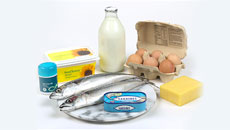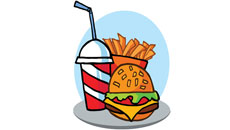Decoding what you consume and purchase to achieve a healthy, well-balanced diet and conscious food choices
In this modern era, we are often inundated with words like organics, raw food, pesticides, Ocean Wise program, sustainable seafood, fair trade and organically raised/free-range meats – but what does it all really mean? How does an individual decode what to eat, what to purchase and how to achieve a healthy, well-balanced diet, while still trying to be ethical and conscious of our food choices and purchases? This feature will attempt to decode and provide knowledge in the hopes of raising greater awareness of how to achieve a healthy, happy lifestyle starting with what you put into your body.
What is Organics?
“Organic foods are farmed in an environmentally sustainable and socially responsible way, focusing on soil regeneration, water conservation and animal welfare,” according to the Certified Organic Associations of British Columbia (COABC). “Organic farming promotes the sustainable health and productivity of the ecosystem – soil, plants, animals and people.”
Organic farmers do not use synthetic pesticides, herbicides, fertilizers or genetically modified organisms (GMO) to grow their produce or grains. In addition, this form of farming strives to be humane in the treatment of animals – organically raised poultry, cattle or other animals are fed a certified organic diet (free of hormones, GMOs or animal by-products). To prevent disease, the animals are not caged indoors but are free to roam in pastures or spacious shelters to not only promote exercise and a natural lifestyle, but to allow the animals to remain in contact with one another in a natural manner.
Furthermore, many processed foods contain additives, artificial flavouring and chemical preservatives, however processed organic foods do not contain chemical preservatives or synthetic additives like colourings and waxes.
Preet Marwaha, CEO and Founder of OrganicLives, is often asked by individuals “Why should I eat organics?” He says there are several layers to this answer, starting off by stating when individuals go organic, they “automatically eliminate 400 toxic pesticides that go into growing our food, those pesticides not only end up in our bodies, our water systems and our soil systems, literally everywhere around the world.”
He then talks about individual’s overall health and states the following questions: “What impact does it have on our health putting all these toxins into our body? What are we doing when we compromise the quality and health of the soil? How does that compromise the nutrition of the food? How does it affect the livelihood of people that are exposed to these toxic chemicals and pesticides without knowing how toxic they are?”
“My passion is really around change, how do we make a difference in the world? We are using food as that medium, as that catalyst,” says Marwaha. “OrganicLives is really a culmination of my life, my experiences and the knowledge I’ve acquired, bringing that all back to a place where we can reconnect ourselves with the food we’re eating, understand how it impacts our health and connects to our planet’s health and how its connected to the social issues we have in this world, whether it’s global warming, poverty, hunger, species extinction, deforestation, water contamination, soil erosion and the list goes on – all these things are connected to our food choices.”
All around the world, organic farming is being practiced, and more than 24 million hectares of agricultural land are managed organically, more so in Europe, Australia and North America, according to the ‘International Federation of Organic Agriculture Movements’ report.
Organic Farming in BC
Since 2001, the number of certified organic farms in Canada has grown nearly 60 per cent from 2,230 farms to 3,555 farms in 2006, according to a Statistics Canada report. British Columbia is Canada’s most diverse farming province, with more than 200 commodities produced on the land. According to the Ministry of Agriculture, there are 600 certified organic farms, including those in the process of certification, operating in BC covering 24,000 hectares, plus 200 certified organic food processors. The province’s organic farmers produce fruits, vegetables, meats, grains and root crops.
“Organic farming and foods is full of opportunities in BC. The current generation of growers and producers is focusing on high-quality, value-added products and exploring niche markets at home and abroad,” says BC Minister of Agriculture Don McRae.
McRae and the Ministry of Agriculture, along with stakeholders including COABC, have been working together to create the ‘Agrifoods Strategy,’ which focuses on BC’s strengths and maximizes the benefits and opportunities for BC farmers, workers and communities. In addition, the strategy recognizes the opportunities for BC’s organic growers and food producers and identifies enhancing organic market access as a goal.
McRae went on to say, “BC’s organic foods consumers are very loyal, whether they are shopping at the more than 125 Farmers’ Markets around the province, at the farm or in large supermarkets. Many consumers feel that BC’s organic foods offer good value, and we’re working with growers and retailers to build on that consumer loyalty and demand.”
What is the Raw Food Diet?
The raw food diet has been around for centuries, since the beginning of time when humans consumed food without using fire or stoves. It gained popularity in the 1930s in the United States, and with the organics movement in the 1980s, there has been a huge explosion in the awareness of the raw food/organic diet with many followers, including stars like Demi Moore, Shania Twain, Woody Harrelson and Tony Robbins.
“The raw food diet is actually a whole lifestyle. People often ask me, “What do you eat? Salad, beef tartare, sushi? No, to the latter two. We focus on fruits, vegetables, nuts and seeds – all of these are unprocessed, so not heated, roasted or dried. The foods are not heated above 118 degrees,” says Janice Skoreyko, CEO and Founder of Raw Foundation Culinary Arts Institute.
She says most people following a raw food diet are following a raw vegan diet so consuming no meat and sometimes no honey. Skoreyko is often asked, “How do you get your protein intake?” She responds, “On this lifestyle, we are getting all of our protein the way every other vegetarian animal gets their protein. Bananas, greens, every single food on the planet has protein. We have been schooled in a certain way that has us believing animals equal protein, while that’s true, that’s definitely not the only source.”
In her many roles, Skoreyko is also a certified nutritionist and a health educator, who often speaks with athletes from football players to triathletes, who are concerned with the protein factor. She asks them “If there was one animal you would like to look like, what would it be?” The most popular response is gorilla, as the animal is equated to strength, agility and is muscular. When examining the gorilla’s diet, Skoreyko points out the animal consumes bananas, bamboo shoots and greens.
She says the raw food diet is not boring, contrary to popular belief. “We eat coconut cream pie, lasagna, pasta, brownies and kebabs, so you’re not limited by any stretch of the imagination. Anything that you can make in the cook food world, we can re-create in the raw food world if you’re craving something.”
Gluten, Dairy and Soy
Over the last few decades, there has been a rise in individuals who are being diagnosed as allergic to wheat (gluten), dairy and soy to name a few foods. Many individuals have had to change they way they think about food in order to eliminate the foods that are negatively affecting them, and find solutions that work for their revised diets.
Both the Raw Foundation and OrganicLives are gluten, dairy and soy free establishments. According to Skoreyko, the raw food diet is completely void of gluten, soy and dairy. “When those are gone from the diet and they’re causing an irritation or inflammation in the body, when that’s eliminated, the body is able to heal. So, you become much stronger and the bio-terrain becomes stronger, and eventually those type of allergies may move to the wayside because allergies are showing up when our bodies are compromised. If our bodies are strong, then we won’t have the weaknesses showing up,” she adds.
Marwaha says there are ongoing debates about gluten, dairy and soy products. For gluten, it is overly processed and humans are consuming too much of it, plus “gluten causes damage in bodies, it’s just not good for the body and it’s not sustainable for the planet the way it’s being grown and produced,” he adds. Marwaha provides an example of a loaf of bread; it doesn’t grow on a tree and has to undergo a process, including bleaching and deodorization. There is “so many chemicals and pesticides, and the sustainability isn’t there. The way we used to consume grain thousands of years ago is much different than what we’re doing now.”
He goes on to say soy is processed and “one of the most heavily genetically modified foods after corn.” As for dairy, he points out that humans are the only species in the world that consumes the milk of another species. “We consume it in an unnatural form” and refers to a study in which milk was fed to baby calves, and they calves got sick and died. “The milk designed for them is killing them, what is it doing to us?”
Both OrganicLives and the Raw Foundation source their ingredients with due diligence from paying attention to where the food comes from to how it’s manufactured or planted with the goal to source organic, sustainable and fairly traded products.
“We try to understand our farmers and sources, and we work with fair trade farmers in Canada and other parts of the world,” adds Marwaha.
Health Benefits
Why is your diet important to your overall health?
“A healthy diet provides the essential nutrients that the body requires for its every function. Eating a diet rich in whole foods such as vegetables, fruit, meat and whole grains and avoiding processed food, sugar, caffeine and alcohol can make significant health improvements for any person,” says Dr. Heidi Rootes, a naturopathic physician and certified prolotherapist.
Rootes goes on to say, “Eating nutrient rich food improves energy, mood, sleep and cognition. It is essential to our heart, lungs, gastrointestinal tract and brain. Not only does food provide our body with the nutrients it needs to function properly but avoiding foods that contain pesticides, additives, hormones and antibiotics will reduce the risk of cancer, Alzheimer’s disease, allergies and other health conditions associated with consumption of toxins.”
Both Marwaha and Skoreyko had life-threatening illnesses and were told they were going to die, but they overcame their illnesses in large part due to their lifestyle changes, in particular diet. Marwaha began to study food, nutrition and science to anatomy, chemistry and physiology to better understand the body and its connection to food and overall health. He became friends with John Robbins, an American author, who popularized the links among nutrition, environmentalism and animal rights, who he credits for saving his life.
“There are so many benefits with raw food, where do I start? It’s awesome to see we’re going back to what nature actually created and intended for us to consume and eat,” he says. “The health benefits are vast, starting with just your overall health, what you can actually do when you’re healthy is phenomenal.”
While Skoreyko, who suffered from a number of ailments from an early age, travelled around the world from China to the Mediterranean seeking answers. She became very sick in China and says I was “on my death bed,” could only drink coconut water and eat pineapple and spent over 10 days in bed. After this however, she bounced back and thought to herself, “I’m on to something, it’s not about being vegan or vegetarian, it’s about connecting to myself and what does my body need – [the answer was] fresh food.” She studied with Jeanne Marie Martin, who introduced her to the concept of healing with whole foods, which led her to experiment and gain an appreciation of the link between food and a healthy lifestyle.
“It’s not complicated, get back to the basics, start eating fruits and vegetables. Shop on the parameters of the supermarket, not in centre that’s where all the packaged food is,” she says.
Why not pay for healthy, vital foods that are beneficial to your well being, than having to pay for medications and supplements when your health is poor? Both Marwaha and Skoreyko share this sentiment, and she says “It’s expensive to continue to consume foods that are nutrient deficient. It’s the first time in history, where there’s an abundance of food but we are the most starved as a society –starving ourselves to death nutrient wise.”
When individuals hear the term organic, they have this “perception that it is ridiculously expensive, but it’s really not anymore. I do full audits on people’s homes and the foods in it. When they switch to organic and a whole food life style, it only costs 10 to 15 per cent more, that’s not a lot when you think about the price of our health and the money it’s going to cost our healthcare by putting these toxins and chemicals into our body.”
Recently, the Ministry of Health provided a $2-million, one-time grant to the BC Association of Farmers’ Markets to provide increased access to locally grown produce and food products for lower-income seniors and families in the province.
“We are proud to support [this initiative], which is helping to improve the health of BC families by offering increased access to locally produced food for those in the most need,” says Minister of Health Michael de Jong.
More than 125 farmers’ markets operate throughout BC providing a variety of healthy-produced foods.
Ocean Wise/Sustainable Seafood
Living on the West Coast, we are a seafood mecca of diverse fish species to shrimp, scallops and oysters. However, “overfishing is the most immediate and largest threat to the marine environment,” says Mike McDermid, Ocean Wise Partner Relations Manager.
The world’s marine life is quickly being depleted and it is estimated that 90 per cent of all large, predatory fish have already disappeared. “The worldwide fisheries will collapse by 2048” and the only solution is to consume seafood in a sustainable manner, according to a scientific, research article (Impacts of Biodiversity Loss on Ocean Ecosystem Services) by Boris Worm and several authors.
In 2005, the Vancouver Aquarium partnered with Chef Robert Clark and C Restaurant of the Kambolis Restaurant Group to create the Ocean Wise conservation program to educate and empower consumers about the issues surrounding sustainable seafood.
Known for its conservation efforts over the last 56 years, the Vancouver Aquarium wanted to develop a program to provide individuals with information on what they can do in their daily lives that will have a positive impact from climate change and global warming to negative impacts on marine and aquatic environments, says McDermid.
As for the Ocean Wise program, the goal is to inform consumers about the choices they’re making in terms of sustainable vs. non-sustainable seafood choices. “What is the right thing to buy? We can find out and do research, tell people what is a good/bad fishery and farm. We took it one step further and got businesses involved, so it was possible for consumers to find the products. Local chefs, grocery stores, and markets were receptive to learning about sourcing sustainable/non-sustainable seafood options” and providing the highest quality of seafood for their customers, adds McDermind.
Ocean Wise’s recommendations are based on four criteria. An Ocean Wise species is:
Abundant and resilient to fishing pressures
Well managed with a comprehensive management plan based on current research
Harvested in a method that ensures limited bycatch on non-target and endangered species
Harvested in ways that limit damage to marine or aquatic habitats and negative interactions with other species
The program launched an Ocean Wise logo, which is visible on restaurant menus, markets and food-service outlets throughout Canada.
Currently, there are over 450 participating members, including over 70 large-scale seafood distributors and suppliers, with over 3,100 locations that are “committed to providing ocean-friendly alternatives for their customers,” according to the Vancouver Aquarium.
“Ultimately what the goal is of Ocean Wise is to not only work with chefs, help them make better choices and have them clearly identify those right on their menus, but to work with other businesses, like a grocery store displaying the Ocean Wise symbol on their seafood display cases. It makes it easy for consumers to see the symbol on a menu or at the grocery store and that you’re making the best choice for the health of the oceans and it’s been verified by the Vancouver Aquarium,” says McDermind.
“So, that’s how it makes it easier for consumers and that’s why consumers have bought into it so well. Most people like to be part of the solution and not the problem, so 9 times out of 10, people will pick the more sustainable option,” he adds.
To Sum It Up
Marwaha has been studying the different types of eating and living for years, and has found the consumption of fat isn’t really changing. “We need to be more conscious of what we’re putting into our bodies. Simply, when you shift to a healthier lifestyle, the goal is to become healthier, goal is to put more food into our body that it needs – the fuel.”
He has a car analogy for this: “fuel for car is gasoline, if oil represents fat, you’re not going to keep bloating your engine with oil, it only needs so much. When you overload engine with oil, it’s going to leak out and your gaskets are going to go with oil seeping in different parts of the engine, and that’s a problem in itself, eventually the engine will break down.”
“That’s how I look at the body – oil is the fat, can only put so much into body, our body only needs so much of it, after that it starts seeping into body and coating everything in our bodies, our cells and clogging everything up.”
“For optimal health, if you truly want to live a life where you have no indigestion, gas, bloating, heart burn, acid reflux and you can eliminate disease, colds, flu’s – all of these things, you can do that, just by changing the way you eat.”






